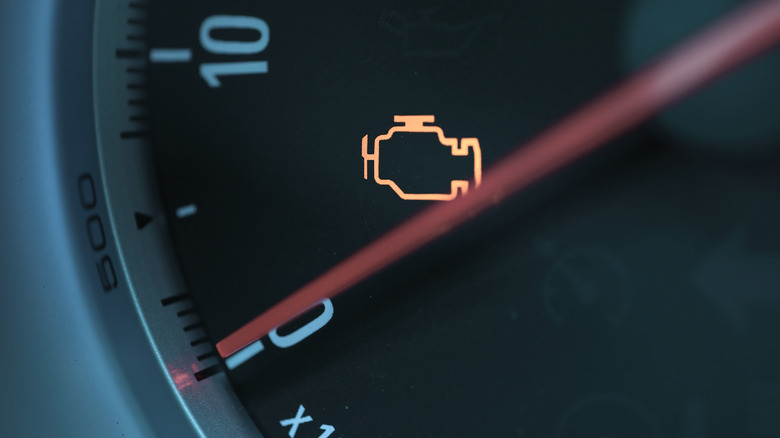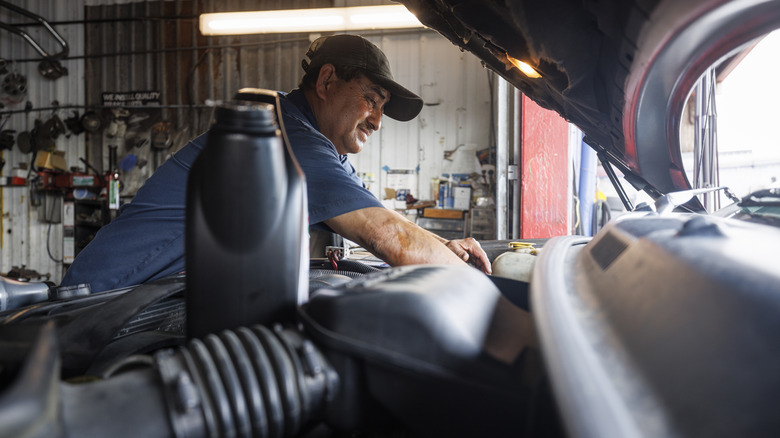When A Solid Check Engine Light Turns On, How Long Is It Safe To Keep Driving?
Modern-day vehicles are equipped with numerous sensors designed to monitor every aspect of the car. If one of these systems detects an issue, it is likely to trigger the warning system, which will alert you to the problem. It's important to understand what some of the most common dashboard warning lights mean so that when they come on, you know which car part to address. Sometimes these warning lights can flash once, turn on intermittently, or stay on for an extended period of time. The check engine light can be any of the three. So, what do you do when a solid check engine light turns on, and how long is it safe to keep driving if that happens?
In most cases, you can continue driving for a short while without risking major harm. As Dave Cappert at the National Institute for Automotive Service Excellence (ASE) explained to Consumer Reports, a solid check engine light "doesn't mean you have to pull the car over to the side of the road and call a tow truck. It does mean you should get the car checked out as soon as possible." However, if the light coming on is accompanied by a serious problem such as overheating, fuel leaks, or severe loss of power, it is best to stop immediately.
What does a solid check engine light signal?
Some of the most common reasons for a solid check engine light include a loose gas cap, emissions system problems, a faulty oxygen or mass airflow sensor, or worn spark plugs. When it comes on, it is best to keep your speed moderate, avoid heavy acceleration, and keep your mileage to a minimum until the problem is diagnosed. Treat the solid light as an early warning to plan an immediate service, not as a pass to ignore the issue until the light starts flashing.
It is also important to note that, if left unchecked, a solid light is often just the first stage of a potentially larger issue that could spiral into an expensive repair bill or even cause irreparable damage to your car. Most vehicles after 1996 will store diagnostic trouble codes (DTC) within the OBD-II when the light first appears. As a result, knowing how to use a code reader to diagnose your car is a great way to pinpoint the problem early, before it turns into something worse.
When to stop driving immediately
Although the car usually remains drivable for a bit when a solid check engine light turns on, you'll need to closely monitor other signals from the car and still be prepared to pull over in case there are issues that pose an immediate danger. Pay close attention to how a car feels on the road and whether any of its other systems are acting out of the ordinary. If the car is performing subpar or has a poor fuel economy, it's best to stop driving, as these symptoms could point to a catalytic converter problem that could turn into a very costly repair.
Another potential cause of a check engine light is an overheating engine. If this is something you encounter, pull over immediately and shut the car off to prevent severe engine damage. Sometimes a stable check engine light can also be triggered by an issue with the car's fuel system. If you notice a particularly strong fuel odor around and inside the car accompanied by a solid check engine light, be sure to pull over immediately as this may signal a fuel leak or unburned fuel entering the exhaust, both of which pose a fire risk.
In most cases, a solid check engine light is not an issue that requires immediate attention. If it is paired with symptoms that affect the car's safety and performance, however, it's best to stop driving right away. In contrast, when a check engine light is flashing, the safest move is to stop immediately and avoid driving any further.


